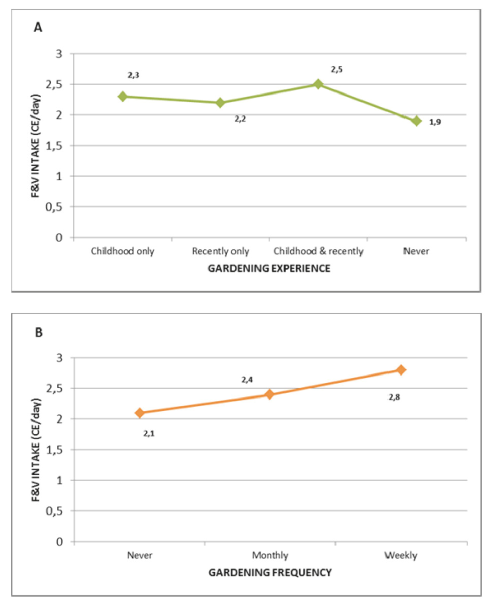Gardening Experience and Fruit and Vegetable Intake Among First-year College Students
During their first year, college students usually gain unwanted weight. This is related in part to the transition of leaving home and now caring for themselves. During this period, students often consume more convenience and readily available foods that are typically dense in energy and poor in nutrients. Gardening initiatives among children seem promising to enhance their dietary habits and to increase fruit and vegetable consumption. Yet, we don’t know if similar initiatives could be effective for older adolescents and college students. The major aim of this study was to examine whether there’s a relation between having gardening experiences in childhood as well as recently, and a higher intake of fruit and vegetables (F&V) among a diverse sample of first year college students.
Gardening intervention: a strategy to encourage F&V consumption
Gardening programs have been used historically to promote sustainable and environmentally friendly farming practices and to encourage active learning in school. Recently, gardening initiatives are being used to enhance children’s eating behavior, and specifically to increase F&V consumption1. School gardening programs often associate nutrition lessons with opportunities for students to work in a garden2,3.
The short-term effects of gardening are known: it increases F&V intake among school-aged participants during or immediately after the intervention period4,5. Studies have found that gardening experiences increase both nutrition knowledge and vegetable preferences2,3. Other studies have also shown that participating in community gardening once a week can significantly increase F&V intake for adults and children. However, there’s lack of information concerning the long term implications of gardening interventions.
Gardening experience & frequency and F&V intake among first year college students: Long term effects of gardening
The study included 1,121 first-year students, aged 18 years or older and consuming on average <2 CE (cup equivalents) of fruit or >3 CE of vegetables daily.
Height and weight were measured to calculate participants’ BMI and multiple questionnaires were administrated:
- Lifestyle and health-related questionnaires;
- The National Cancer Institute’s Fruit and Vegetable Screener;
- Questionnaire including a set of questions about gardening experiences in childhood and in the previous 12 months.
Eleven percent of the participants reported gardening only during childhood, 19% reported gardening only recently, 20% reported gardening both during childhood and recently and 49% reported that they have never gardened. Furthermore, 60% of the students reported that they didn’t garden recently, while 31% indicated gardening on a monthly basis (1 to 3 times/month) and 9% gardened weekly (at least once per week). Figure 1a shows that participants who gardened during childhood and recently, had significantly higher F&V intake (2.5 CE/day) compared with those who never practiced gardening (1.9 CE/day).
Concerning the frequency of recent gardening, it was positively associated with F&V intake. Among the participants who reported not gardening recently, the average F&V intake was 2.1 CE/day, while those who reported gardening monthly had an average F&V intake of 2.4 CE/day, and 2.8 CE/ day among those reporting weekly gardening (Figure 1b).

Figure 1: Fruit and vegetable intake by gardening experience (1a) and by frequency of gardening in the past 12 months (1b).
Policy makers should develop gardening programs at schools to increase F&V consumption among students
The study results support that gardening is a strategy that can increase F&V consumption among college-aged students who don’t currently meet national F&V recommendations. To provide a more significant effect on F&V intake, gardening should be practiced at multiple time points and at a sufficient frequency.
Given the positive association between F&V intake in terms of both history of experience and frequency of engagement, policy makers should develop gardening programs at schools, colleges and universities to increase youth and adolescents’ exposure to gardening.
Based on: J. Loso, D. Staub, SE. Colby, MD. Olfert, K. Kattelmann, M. Vilaro, J.Colee; W. Zhou, L. Franzen-Castle, AE. Mathews. Gardening Experience Is Associated with Increased Fruit and Vegetable Intake among First-Year College Students: A Cross-Sectional Examination. J Acad Nutr Diet 2017 Nov. https://doi.org/10.1016/j.jand.2017.09.005
References
- Corrigan MP. Growing What You Eat: Developing Community Gardens and Improving Food Security [dissertation]. Athens, OH: Ohio University; 2010.
- Hermann J, Parker S, Brown B, et al. After-school gardening improves children’s reported vegetable intake and physical activity. J Nutr Educ Behav. 2006; 38(3):201-202.
- Ratcliffe M, Merrigan K, Rogers B, et al. The effects of school garden experiences on middle school-aged students’ knowledge, attitudes, and behaviors associated with vegetable consumption. Health Promot Pract. 2011;12(1):36-43.
- Savoie-Roskos M, Wengreen H, Durward C. Increasing fruit and vegetable intake among children and youth through gardening-based interventions: A systematic review. J Acad Nutr Diet.2017; 117(2):240-250.
- Evans C, Christian M, Cleghorn C, et al. Systematic review and meta-analysis of school-based interventions to improve daily fruit and vegetable intake in children aged 5 to 12 y. Am J Clin Nutr.2012;96(4):889-901.
